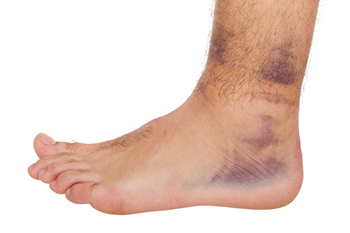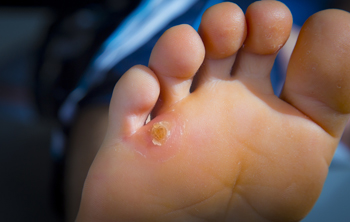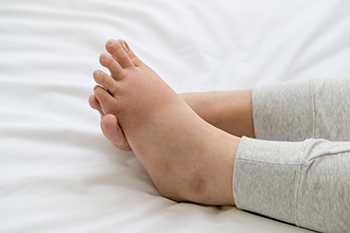Items filtered by date: April 2022
Spraining an Ankle

An ankle sprain occurs when the foot inverts and twists causing the ankle joint out of its normal position. The ankle injury is sustained on the lateral ankle complex, composed of three ligaments – talofibular, calcaneofibular, and posterior talofibular – that hold the ankle bones and joints together. There may be small tears and damage to tendons, cartilage and blood vessels and there will usually be pain when weight is placed on the affected ankle, swelling, and even bruising. Anyone can sprain an ankle but those who participate in sports, walk on uneven surfaces, or wear inappropriate footwear are more at risk. It can take several weeks, even months for a sprained ankle to heal completely. Calling a podiatrist is suggested if you feel you might have sprained your ankle to determine how severe the injury is, make sure it is not broken through various manipulations and one or more imaging studies, and to provide the proper course of treatment.
Ankle sprains are common but need immediate attention. If you need your feet checked, contact Dr. Douglas Mckay from New Jersey . Our doctor can provide the care you need to keep you pain-free and on your feet.
How Does an Ankle Sprain Occur?
Ankle sprains take place when the ligaments in your ankle are torn or stretched beyond their limits. There are multiple ways that the ankle can become injured, including twisting or rolling over onto your ankle, putting undue stress on it, or causing trauma to the ankle itself.
What Are the Symptoms?
- Mild to moderate bruising
- Limited mobility
- Swelling
- Discoloration of the skin (depending on severity)
Preventing a Sprain
- Wearing appropriate shoes for the occasion
- Stretching before exercises and sports
- Knowing your limits
Treatment of a Sprain
Treatment of a sprain depends on the severity. Many times, people are told to rest and remain off their feet completely, while others are given an air cast. If the sprain is very severe, surgery may be required.
If you have suffered an ankle sprain previously, you may want to consider additional support such as a brace and regular exercises to strengthen the ankle.
If you have any questions please feel free to contact one of our offices located in Caldwell, and Galloway, NJ . We offer the newest diagnostic and treatment technologies for all your foot and ankle needs.
What Can I Do About Swelling in My Feet and Ankles?
Swelling in the feet and ankles (edema) is caused by fluid that builds up in these areas. It is often the result of standing or walking for too long, having too much salt in your diet, being overweight, or being pregnant. Several medications, such as steroids, blood pressure meds, contraceptives, and antidepressants, may also cause swelling in the extremities. Other causes include blood clots, kidney or liver problems, bee sting or insect bite, or infection. Symptoms of edema are shiny, red, or stretched skin and puffy feet, ankles, and lower legs. Ways to reduce the swelling include keeping your foot elevated when sitting or lying down, doing simple exercises to encourage blood flow, and wearing wide, comfortable shoes with a low heel and soft sole. If you have frequent bouts of edema, or if the swelling does not recede after a few days, it’s a good idea to check in with a podiatrist for an examination and recommended treatment options.
Everyday foot care is very important to prevent infection and other foot ailments. If you need your feet checked, contact Dr. Douglas Mckay from New Jersey . Our doctor can provide the care you need to keep you pain-free and on your feet.
Everyday Foot Care
Often, people take care of their bodies, face and hair more so than they do for their feet. But the feet are a very important aspect of our bodies, and one that we should pay more attention to. Without our feet, we would not be able to perform most daily tasks.
It is best to check your feet regularly to make sure there are no new bruises or cuts that you may not have noticed before. For dry feet, moisturizer can easily be a remedy and can be applied as often as necessary to the affected areas. Wearing shoes that fit well can also help you maintain good foot health, as well as making it easier to walk and do daily activities without the stress or pain of ill-fitting shoes, high heels, or even flip flops. Wearing clean socks with closed shoes is important to ensure that sweat and bacteria do not accumulate within the shoe. Clean socks help to prevent Athlete’s foot, fungi problems, bad odors, and can absorb sweat.
If you have any questions please feel free to contact one of our offices located in Caldwell, and Galloway, NJ . We offer the newest diagnostic and treatment technologies for all your foot and ankle needs.
How to Measure for Shoe Size
Always measure your feet if you have any questions about your proper shoe size. You can measure your own feet with a tape measure or ruler, paper, a writing implement, and a chair to sit on while measuring your feet. First, tape the paper to the floor so it will not move. Second, sit on the chair and put one foot on the paper. Make sure to wear socks or foot coverings that you plan to wear with shoes before placing them on the paper. Third, outline the outside of your foot with your pen or pencil. Do this for both feet to check subtle differences that might be present between your feet. Fourth, measure from the tip of the heel to the longest toe of your foot and make a note of the numbers. Finally, do some simple math – subtract 3/16 from the measurement you wrote down to account for the difference between your foot and the shoe. The result is your shoe size! If you have trouble measuring your feet properly or find that you are still not able to find comfortably fitting shoes, see a podiatrist for help in measurements, and shoe suggestions, or to help you detect any other problems that might be going on with your feet.
Getting the right shoe size is an important part of proper foot health. Seek the assistance of Dr. Douglas Mckay from New Jersey . Our doctor will provide the care you need to keep you pain-free and on your feet.
Getting the Right Shoe Size
There are many people who wear shoes that are the incorrect size, negatively affecting their feet and posture. Selecting the right shoes is not a difficult process, so long as you keep several things in mind when it comes to choosing the right pair.
- When visiting the shoe store, use the tools available to measure your foot.
- Be sure there is ‘wiggle room’. There should be about an inch between your toes and the tip of your shoes.
- Do not always assume you are the same size, as manufacturers run differently.
- Purchase shoes later in the day, as your feet swell as the day progresses.
- If a shoe is not comfortable, it is not suitable. Most shoes can’t be ‘broken in’, and comfort should be the ultimate goal when it comes to choosing the right pair of shoes
As our feet hold our body weight and keep us moving, it is important to treat them right. Picking the right pair of shoes can provide your feet comfort and mobility without pain.
If you have any questions, please feel free to contact one of our offices located in Caldwell, and Galloway, NJ . We offer the newest diagnostic and treatment technologies for all your foot care needs.
Types of Corns
 Repeated friction on the foot can result in developing corns. They are hardened areas of skin, and some can cause pain and discomfort. There are three kinds of corns, consisting of hard, soft, and seed. Corns that form on the sole of the foot are referred to as seed corns, and they are generally found in groups. Hard corns can form on top of the toes, and may come from wearing shoes that do not fit correctly. Soft corns are found between the toes, and are typically moist. Relief for most corns can be found when the correct shoes are worn, and wearing specific socks may help to reduce some of the friction. Some patients can experience pain with corns, and it may interfere with completing daily activities. If you have developed any type of corn on your foot, it is suggested that you confer with a podiatrist who can provide the best options for you.
Repeated friction on the foot can result in developing corns. They are hardened areas of skin, and some can cause pain and discomfort. There are three kinds of corns, consisting of hard, soft, and seed. Corns that form on the sole of the foot are referred to as seed corns, and they are generally found in groups. Hard corns can form on top of the toes, and may come from wearing shoes that do not fit correctly. Soft corns are found between the toes, and are typically moist. Relief for most corns can be found when the correct shoes are worn, and wearing specific socks may help to reduce some of the friction. Some patients can experience pain with corns, and it may interfere with completing daily activities. If you have developed any type of corn on your foot, it is suggested that you confer with a podiatrist who can provide the best options for you.
Corns can make walking very painful and should be treated immediately. If you have questions regarding your feet and ankles, contact Dr. Douglas Mckay of New Jersey . Our doctor will treat your foot and ankle needs.
Corns: What Are They? And How Do You Get Rid of Them?
Corns are thickened areas on the skin that can become painful. They are caused by excessive pressure and friction on the skin. Corns press into the deeper layers of the skin and are usually round in shape.
Ways to Prevent Corns
There are many ways to get rid of painful corns such as:
- Wearing properly fitting shoes that have been measured by a professional
- Wearing shoes that are not sharply pointed or have high heels
- Wearing only shoes that offer support
Treating Corns
Although most corns slowly disappear when the friction or pressure stops, this isn’t always the case. Consult with your podiatrist to determine the best treatment option for your case of corns.
If you have any questions please feel free to contact one of our offices located in Caldwell, and Galloway, NJ . We offer the newest diagnostic and treatment technologies for all your foot and ankle needs.




